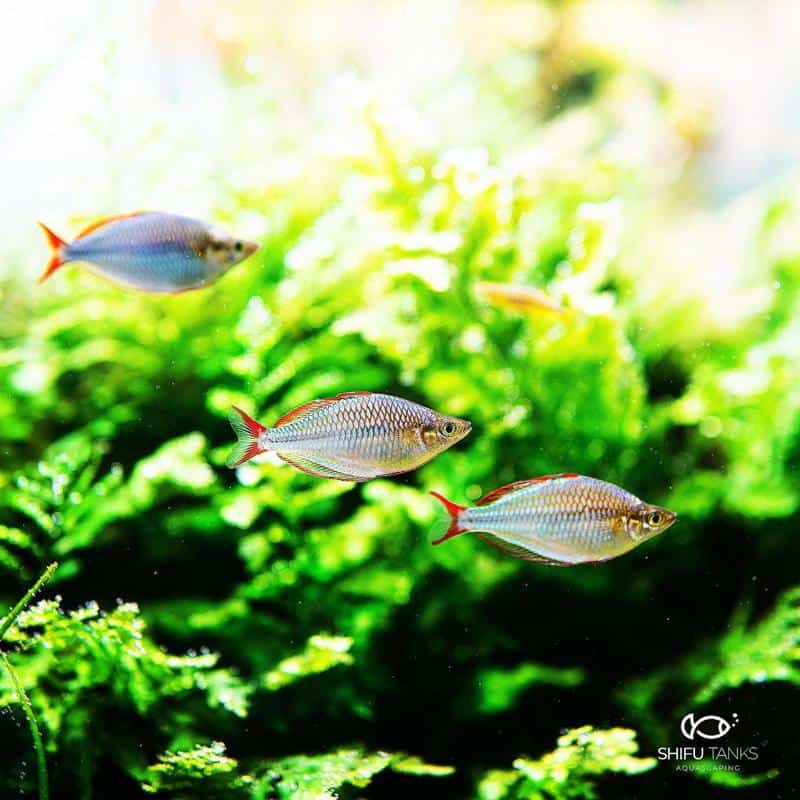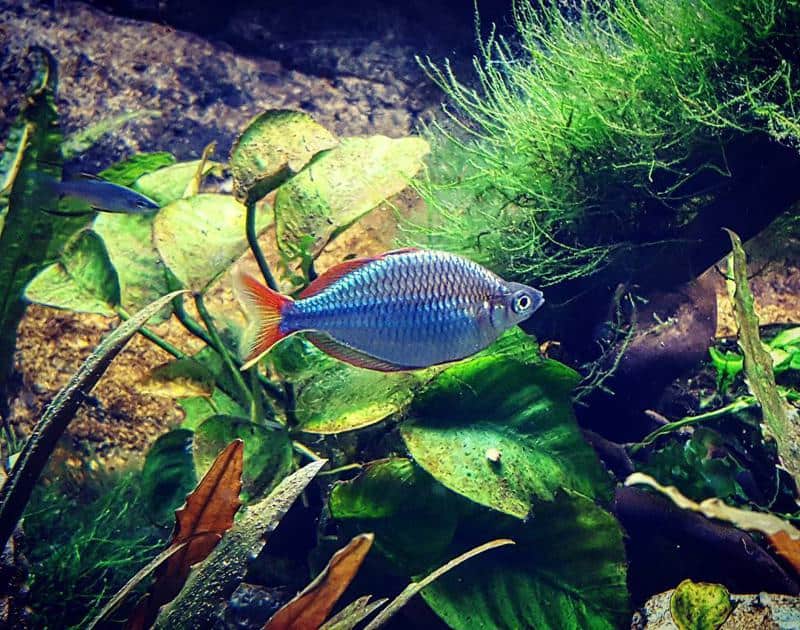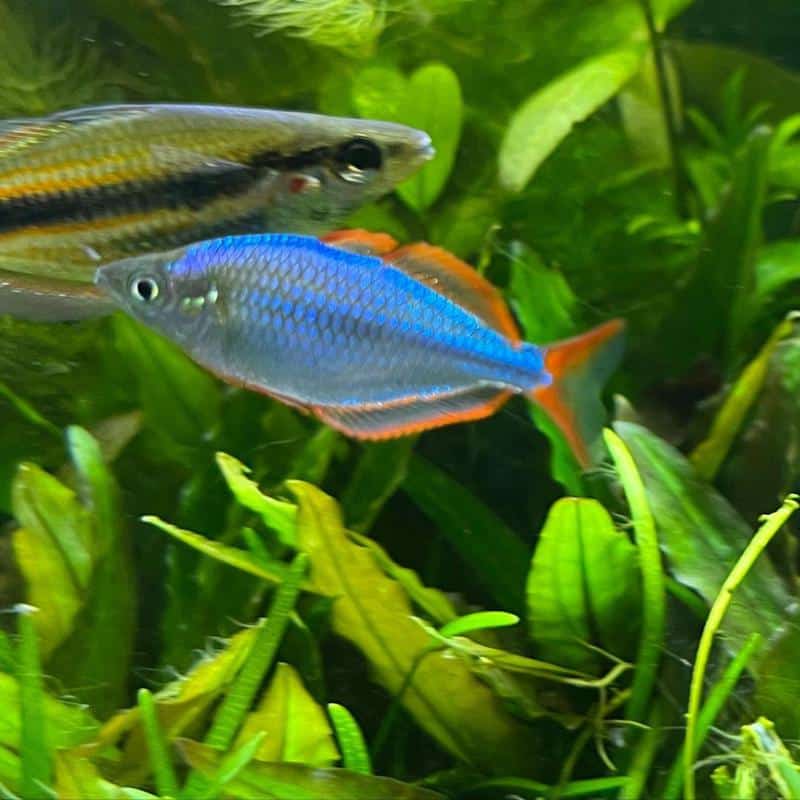Many aquarists prefer to keep small-sized fish, and one of the numerous choices is the freshwater Rainbowfish.
While there are over 100 species within their family, one of their tiniest types, the Neon Rainbowfish, has captivated both newbies and experienced hobbyists.
But if you look at the Neon Rainbowfish, it may give you the impression that this is just an ordinary fish. So, why have they fascinated us?
Join us in this article as we present the life of this seemingly normal fish that reflects light and creates an enchanting rainbow luminance.
Neon Rainbowfish Characteristics
Small and Luminous
Reaching a maximum size of 3 inches (8 cm) long, the Neon Rainbowfish (Melanotaenia praecox) is one of the smallest species within their Family Melanotaeniidae.
While Melanotaenia translates into “black bands” that run along the body, this generic feature is less pronounced in the Neon Rainbowfish. Instead, their pearlescent color is what’s prominent in them. Looking closely at their body, you will see that their silvery blue skin color reflects light. In effect, a rainbow spectrum radiates.
In pet shops, Neon Rainbowfish are sold under an inch in length (usually from 0.5 to 1-inch max). They are typically displayed in school in a species-only tank. But it doesn’t mean that they should be kept alone when you bring them back home since they can also thrive in a community tank with compatible tank mates.
Almond-shaped Body and Double Dorsal Fins
We are pretty sure that after you closely examine your Neon Rainbowfish, two of their distinct body parts will get your attention.
By this time, you may have noticed that their body is not shaped regularly, like in other aquarium fish. It is because their streamlined and elongated body slightly bulges on the dorsal fin part, resembling like an almond.
Speaking of dorsal fins, this body part is featured uniquely in Neon Rainbowfish. Unlike the singular and continuous dorsal fin most fish have, Neon Rainbowfish have two dorsal fins. While it is not visible when unraised, you can clearly see a gap separating the two dorsal fins when they raise them during social interaction with other fish.
New Guinea Endemic Origins
The Neon Rainbowfish is an endemic species of the 500-mile long Mamberamo River System of New Guinea. While the fast and active swimming traits of Neon Rainbowfish can easily go with the fast flow of this freshwater ecosystem, they favor swamps, marshes and tributaries with lesser water flow.
Neon Rainbowfish prefer shaded areas and their school is often found when there are dense aquatic plants or submerged roots from large trees.
You should take note of their vegetative preference since it is important to replicate this condition when you keep Neon Rainbowfish in the aquarium.
Multiple Common Names
The species Melanotaenia praecox goes by many common names. They are popularly called and tagged in the aquarium industry as Neon Rainbowfish.
However, with regional variations from breeders and aquarists, they are sometimes tagged as the Praecox Rainbowfish, Dwarf Neon Rainbow, or the Blue Neon Rainbowfish.
Growth Requirements

In the wild, Neon Rainbowfish are hardy and can easily adapt to the changing dynamics of their environment. In keeping them as aquarium pets, we would like to provide them with comfortable living and replicate as closely as possible the conditions of their wild habitat.
20-gallon Tank
Despite being small, Neon Rainbowfish require a decent size aquarium (20 gallons at least). The reason for this is they are active swimmers. They love to roam around and providing them with an undersize tank would limit their movement and affect their social behavior and health.
Hard Alkaline Water
Compared to other aquarium fish, Neon Rainbowfish can tolerate a wider range of pH and water hardness. However, if we want to replicate their natural habitat, it is best if we provide them with hard alkaline water.
But how is this possible if our common source is tap water?
Be aware that our tap water is neutral (pH at 7) and soft (4 to 8 gH). To adjust these parameters for your Neon Rainbowfish, add crushed corals to increase your pH and make your water alkaline. Similarly, you can add mineral supplements to increase the gH level and make a hard water environment for your fish.
Rooted Plants
As mentioned earlier, the wild habitat of Neon Rainbowfish is littered with vegetation and you can easily replicate this condition by rooting aquarium plants.
But here’s the thing: you don’t just place plants just for the sake of replicating their wild habitat. Scientifically, your aquarium plants and your Neon Rainbowfish will have a 2-way relationship.
As your plants grow, they absorb excess nutrients in the water column and provide hiding spots for your Neon Rainbowfish. In return, the flourishing of your aquarium flora encourages the natural grazing behavior of your Neon Rainbowfish, making your plants free from biofilm and algae.
Stocking Density
When we place a single Neon Rainbowfish in a 20-gallon tank, it will give us an impression that the aquarium is too large for them. So, the tendency is we place more Neon Rainbowfish in our tank to the point of overcrowding which leads to a change in their social behavior due to the limited space.
You still have to practice their ideal stocking density which is 1 fish for every gallon of water.
Summary of Neon Rainbowfish Growth Requirements
| Parameters | Range |
| Minimum Tank Size | 20 gallons |
| Stocking Density | 1 fish / gallon |
| Temperature | 23 to 27 C (74 – 80 F) |
| Water flow | Moderate to strong |
| pH | 6 to 7.5 |
| Hardness | 8 to 12 dGH |
| Others | Presence of rooted plants |
Feeding Requirements

You will have an easy time feeding your Neon Rainbowfish as they are not picky eaters. Aside from this, feeding is a great moment to enjoy your fish as they shift from active to super-active swimmers as they compete to get the most food.
Non-picky Omnivore
Neon Rainbowfish are omnivores and they eat both plants and animal matter. In the wild, some of their food items include algae, small flies, mosquito larvae, and tiny worms.
In the aquarium, they will eat anything you feed them.
Small food items for their small mouth
Despite not being a picky eater, feeding your Neon Rainbowfish still requires preparation on your part. Be aware that their mouth is relatively small and giving them appropriate food size is crucial.
Choose and prepare the food for your Neon Rainbowfish in such a way that it is equal to or smaller than the size of their mouth.
Preference to Floating or Slow-sinking Foods
When fed upon, the tendency for your Neon Rainbowfish is to go into a feeding frenzy mode. They don’t wait for their food to sink and consume them. Instead, they all simultaneously go to the surface and devour as much food as possible.
Knowing this, floating or slow-sinking foods are preferred when feeding your Neon Rainbowfish. Some of the commercially available feeds you can give them are crushed flakes and nano pellets. Similarly, you can give them small live food like brine shrimps and bloodworms.
Breeding and Propagation
Many aquarists have a successful record in the captive breeding of Neon Rainbowfish. With a little further knowledge about these small fish, you may be on your way to producing your own baby Neon Rainbowfish.
Differentiating Males vs Females
Sexual dimorphism in Neon Rainbowfish is not highly pronounced. Meaning there are a few differences between males and females.
In general, the males are smaller and slenderer than the females. Although a silvery body is common to both sexes, males have a red to orange fins with a blue coloration on their upper body and slowly turning to yellow towards its abdomen, while the females have yellow fins.
It usually takes 4 to 6 months for a Neon Rainbowfish to reach sexual maturity. However, in males, they mature earlier than the females.
Breeding Season
In the wild, the breeding season of Neon Rainbowfish is during the rainy months. Despite other conditions changing within this season, warmer temperatures and increased availability of food are the main triggering factors for their breeding.
To replicate this condition in your tank, maintain your water temperate to its upper limit and increase your pH making your water more alkaline.
When you have a school of matured Neon Rainbowfish and the conditions are conducive for breeding, most probably they will mate and reproduce.
Between the sexes, it is the males that will go into action. Aside from intensifying their body color and displaying their dorsal fins, males will fight especially if there are not enough females in the tank.
Knowing this, it is important to keep 1 or 2 females for every 1 male Neon Rainbowfish.
During mating, the males will ram the abdomen of the female, triggering them to release their eggs.
Non-parental Egg Scatterers
Once the females are induced by the ramming of the males, they will start releasing their eggs and will continue to lay for a couple of days up to a week maximum.
Unlike other fish which lay their eggs in one place, female Neon Rainbowfish are egg scatterers. Meaning, during their week-long spawning, they will just randomly release their eggs anywhere in the aquarium. Consequently, males will continue external fertilization as long as the females are still releasing eggs.
After fertilization, the eggs are left behind by their parents. It takes about a week for the eggs to hatch.
Fry Care and Feeding
When the eggs are hatched, allow the fry to explore their new environment. Do NOT feed them. Newly hatched Neon Rainbowfish fry rely on their yolk sacs for nutrition that can last for a few days.
After which, you can slowly introduce them to feeding and start giving them micro foods like powdered fry food and infusoria. For faster growth and development, feed your fry 3 to 5 times a day in small food rations.
If all goes well, your fry should be large enough that they are ready to consume larger food items like brine shrimp.
Ideal Tank Mates

Except during mating where they are highly active and feeding where they go into a frenzy mode, Neon rainbowfish are generally peaceful and can live with other fish in a community tank.
While they can coexist with other fish, what is crucial for their tank mates is their similarity in water conditions and peaceful temperament. Some of their tank mates include Angelfish, Loaches, Gouramis, Tetras, Cory Catfish, Danios, and other species of Rainbowfish.
Read More: Australian Rainbow Fish
Neon Rainbowfish: FAQs
Do Neon Rainbowfish Eat Shrimps?
Yes, but depending on the species that can fit their small mouth like the tiny Cherry Shrimp. This is the exception for adult Amano, Vampire and Bamboo Shrimp where these species are large enough and do not fit the mouth of a Neon Rainbowfish.
Can I have 1 Neon Rainbowfish?
Yes, but it is not recommended. Be aware that Neon Rainbowfish are schooling and they best thrive if you keep them in groups of 6 or more.
Will Neon Rainbowfish Jump out Of the Tank?
Yes, but they only jump when they feel stressed or threatened. This is very evident when you use a fish net during cleaning or transferring a fish where Neon Rainbowfish will try to get out of its way by jumping out of the water.
What Is the Lifespan of A Neon Rainbowfish?
In the wild, the lifespan of Neon Rainbowfish ranges from 2 to 4 years. In an aquarium setup, if you give your Neon Rainbowfish proper care and maintenance, then you can expect they can live anywhere from 5 to 6 years.
Final Thoughts
With its energetic behavior, small size, and reflecting bodies, Neon Rainbowfish are fast becoming a regular attraction in any aquarium display.
In my case, what caught my attention with Neon Rainbowfish is their perfect harmony and compatibility with aquarium plants. And not just this, aesthetics is significantly improved as the iridescence of Neon Rainbowfish complements the greenery made by my underwater flora.
Try keeping Neon Rainbowfish and you will definitely enjoy them.
